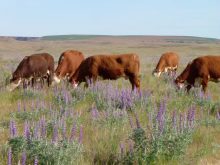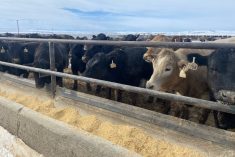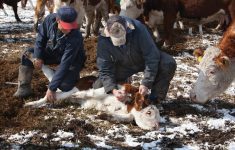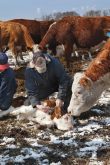Whether you are vaccinating cattle now or later this winter, it’s important to protect most products from freezing to preserve their quality and effectiveness. By exposing the vaccines to freezing temperatures we were compromising the level of immunity we were trying to give the cows.
Here at Whittington Creek in northern Idaho, we’ve been down this road. We’ve been out there processing cattle on days when the mercury gathered in the bottom of the thermometer while the snow piled up for days on end. We recall past winter experiences at the chute: our first years of giving pre-calving vaccine in the winter and cussing the vaccine freezing in the needles, unaware that aside from inconvenience, the larger problem lurked unseen to the naked eye.
Read Also

Harvest wraps up and fall work begins
At the Eppich famly ranch in western Saskatchewan, the fall harvest was successful with few breakdowns, cows and calves have been sorted and a new tractor has arrived
Through the efforts of our Beef Quality Assurance (BQA) programs we have learned the proper methods and locations for injecting the vaccine. In addition, studies begun in 2009 in Arkansas and Idaho are helping producers learn the importance that vaccine storage and handling methods play an important role on potency and quality all the way from the seller of the vaccine to the cow.
In 2009 these studies began with participating retailers and producers placing LogTag data loggers in their vaccine storage refrigerators. Initial temperature data collected from participating retailer’s vaccine coolers across the state of Idaho demonstrated that a substantial number of these coolers did not maintain the recommended 35-45 F (2 -7 C) temperature band for safe storage of vaccine. Only 34 per cent of retailers’ vaccine coolers tested during the Idaho study stayed within the 35-45 degree range 95 per cent of the 48-hour collection period.
Thermometer tells the story
Shannon Williams, University of Idaho extension educator for Lemhi County, one of a group of extension educators participating in the studies, explains the project.
“We placed the data loggers in the retailers’ and producers’ refrigerators and asked that they fill out a survey answering questions regarding their storage and handling procedures,” says Williams. “We collected a minimum of 48 hours’ data from each participant and downloaded this information into spreadsheets for analysis. From the data we collected from the LogTag data loggers, and the surveys, we encourage producers to ask retailers if they monitor temperature and record it regularly.”
In addition to testing the temperature of retailers’ vaccine refrigerators, the study also tested individual producer’s vaccine refrigerators across the state. “Of the participating producers’ refrigerators tested for the study, 67 per cent failed to maintain the proper temperature required by the vaccine manufacturers,” says Williams.
“We anticipated finding the most failure in the really old refrigerators out in the producer’s garage. Surprisingly we found more failures in newer refrigerators that were installed in locations with surrounding air temperature ranges outside of the manufacturer’s recommendations. One producer’s refrigerator performed perfectly for three days in the garage until the outside temperature dropped to -10 F, and then the internal temperature dropped well below the recommended 35-degree minimum required for vaccine.”
Producers can relate to variable refrigerator performance.
“The refrigerator in our house was one of the best tested in the area, but the new refrigerator we put in Mom’s old house (not currently occupied) would not regulate temperature until I put a small heater beside it that kicked on when the house got below a set temperature,” says Bruce Mulkey, a rancher who participated in the study.
Williams recommends producers place thermometers inside their storage refrigerators and regularly monitor the temperature. “In instances where you anticipate storing large quantities of expensive vaccine, use a thermometer that allows you to pre-set a safe band, sounding an audible alarm if the temperature rises or falls outside of that band.”
Armed with this data showing temperature variation with products as they move from the retailer to the producer, Williams and other participants became curious about the conditions vaccine was exposed to between the producer refrigerator and the cow. Participating producers placed thermometers in the coolers they were using to trans- port vaccine from the retailer to home, and from the refrigerator to the chute. The findings revealed that heavier solid-sided coolers were more effective, and soft- sided coolers the least reliable.
Discovering how much temperatures varied within the coolers, several participating producers began to experiment with methods to protect the vaccine beyond the bottle in the cooler. Understanding the risks to the vaccine and realizing that a vaccine gun may be idle for a time between uses, these producers cut holes in coolers to make it easy to insert the gun into the cooler without taking the lid off and on.
A few storage tips
At our ranch on Whittington Creek, through experiences when processing cattle in cold weather with pre-calving vaccinations, we have learned to keep the vaccine in a cooler separate from the vaccine guns. And we monitor the temperature with a digital thermometer attached with double-sided tape to the inside wall of the cooler above the cold/hot source. During cold weather we implemented Williams’ recommendation for keeping vaccine and the guns for safe storage, yet warm enough to handle on cold days. She gives the basic recommendation for cold weather as follows:
- With outside temperature of 36 F (about 2.5 C) no cold/hot source is needed.
- Outside temperature of 29 F (1.5 C) two cups hot tap water in a glass canning jar will maintain a medium-sized cooler within the acceptable temperature range for 4.5 hours.
- Outside temperature of 13 F (-10.5 C) two cups hot tap water in a glass canning jar will maintain a medium-sized cooler within the acceptable temperature range for three hours.
Controlling the temperature of vaccine from the retailer to the cow will prove to be an ongoing challenge for producers. These guideline will help you develop a good storage and handling protocol:
- Ask your retailer about their temperature monitoring.
- Take your own cooler with cold/ hot packs and a thermometer to pick up your vaccine from a retailer, Add or subtract cold/hot packs as needed to regulate the temperature.
- When ordering vaccine, place orders on a Monday to ensure the vaccine does not sit on a loading dock over a weekend. When this vaccine arrives, make sure the cold packs are still cold, and the vaccine is not frozen. If you are concerned about the condition of the vaccine, contact the distributor immediately.
- Monitor the temperature in your vaccine storage refrigerator.
- Preheat or cool your coolers for a least an hour before filling with vaccine.
- Don’t put all of the vaccine for a big day in the cooler at once. Only pack the vaccine needed for the morning or the afternoon.
- Protect your vaccine in coolers with the appropriate cold/hot packs; use a thermometer to monitor the temperature. Take extra packs to add later. Keep coolers out of direct sunlight on hot days.
- Protect the vaccine in your guns from temperature and sunlight by placing in a cooler with adequate cold/hot packs when not actively in use.
- Don’t place vaccine directly on hot/cold sources in the cooler. Cold packs are most effective when placed vertically against the sides of the cooler versus flat on the bottom.
- Discard any vaccine that has frozen or been exposed to hot or cold temperatures outside of the manufacturer’s recommendation for any extended period.















